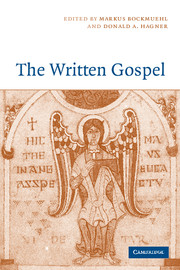Book contents
- Frontmatter
- Contents
- List of contributors
- List of abbreviations
- Introduction
- PART I BEFORE WRITING
- PART II WRITING THE FOUR GOSPELS
- 5 Who writes, why, and for whom?
- 6 How Matthew writes
- 7 How Mark writes
- 8 How Luke writes
- 9 How John writes
- 10 Beginnings and endings
- PART III AFTER WRITING
- Appendix: Graham Stanton's publications
- Bibliography
- Index of ancient sources
- Index of authors
8 - How Luke writes
Published online by Cambridge University Press: 07 December 2009
- Frontmatter
- Contents
- List of contributors
- List of abbreviations
- Introduction
- PART I BEFORE WRITING
- PART II WRITING THE FOUR GOSPELS
- 5 Who writes, why, and for whom?
- 6 How Matthew writes
- 7 How Mark writes
- 8 How Luke writes
- 9 How John writes
- 10 Beginnings and endings
- PART III AFTER WRITING
- Appendix: Graham Stanton's publications
- Bibliography
- Index of ancient sources
- Index of authors
Summary
‘This Gospel is represented fittingly by the calf, because it begins with priests and ends with the Calf who, having taken upon himself the sins of all, was sacrificed for the life of the whole world.’ Thus Ambrose (333–97 ce) describes the ‘Gospel according to Luke’ which, in the subsequent years, has become one of the most beloved of the church's four Gospels. ‘The most beautiful book in the world’ was Renan's estimate. Indeed, the Third Gospel portrays uniquely some of the most loved of Jesus' miniatures of the Kingdom of God in ‘The Good Samaritan’, ‘The Prodigal (Lost) Son’, ‘The Friend at Midnight’, ‘The Persistent Widow’ et al., not to mention one of the most dramatically and beautifully narrated ‘short stories’ in all the Bible, the walk to Emmaus, where the suspense breaks only as Jesus ‘is recognized’ – finally – ‘in the breaking of the bread’.
Yet Luke's Gospel was not apparently the first to be recognized by the church in the second century when written ‘gospels according to’ an apostle or follower of an apostle first emerged. But when the Third Gospel does emerge in the third-century commentary of Origen, it has already established itself as foundational in the celebration of the church year and seems to be preferred for much of the church's admonitions for alms for the poor, particularly as Luke's special material matches catechetical emphases of the Lenten season.
- Type
- Chapter
- Information
- The Written Gospel , pp. 149 - 170Publisher: Cambridge University PressPrint publication year: 2005



